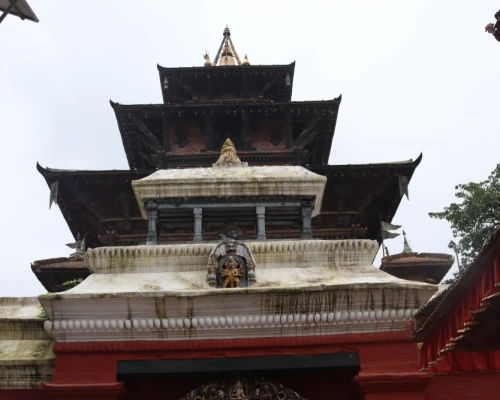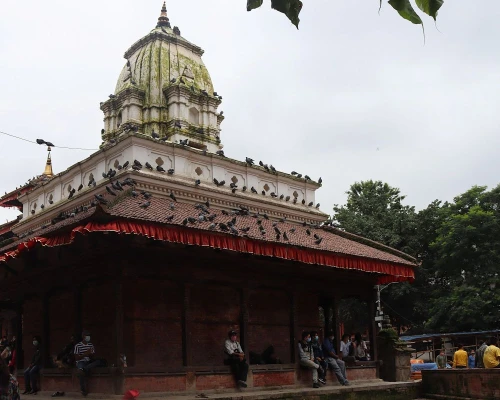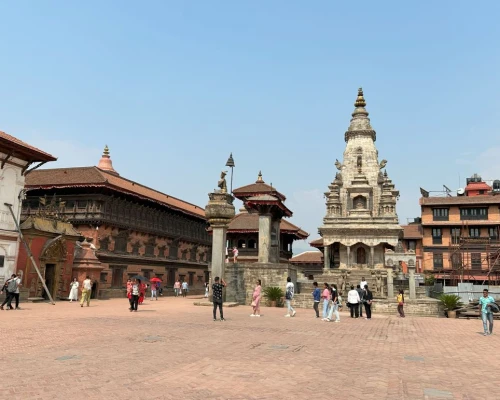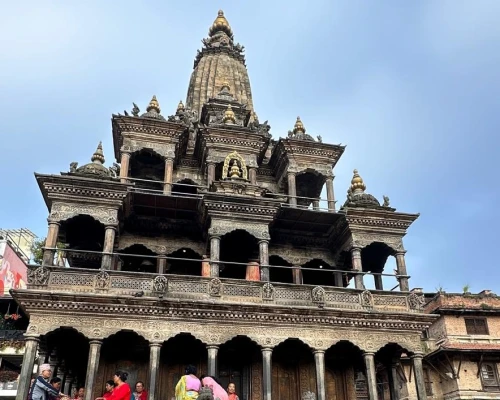Khokana
The Newar farmer population that resides here relies heavily on agriculture, and a large portion of their daily activities take place outside of their homes. Men are smashing seeds, ladies are sitting outdoors spinning, and there are other daily activities going on. The community is well-known for its unique method of collecting mustard oil, which involves crushing the mustard seeds with a large wooden beam in order to release the oil. It is thought that a shared system was formerly employed at this location. This oil can be used for therapeutic massage as well as for ingestion if desired. Prior to Kathmandu, this village—indeed, this entire habitation—was the first to receive electricity.
A three-story temple named Sri Rudrayani is in the community's center, with the main roadway being unusually broad for a village of its size. Khokana, which represents a traditional community and its history of manufacturing mustard-oil seeds, has been proposed for UNESCO World Heritage status.
Khokana is a special village that serves as a good example of a medieval settlement plan with chowks and a drainage system. A Mother Goddess shrine and chaityas are located there. The village's living history is now represented by the production of mustard-oil seeds. Viewing the mountain ranges, among other things, as well as the lovely surroundings and farming on them, may be a lot of fun. The Khokana Festival is an annual event held every August to highlight the distinctive features of the community. On exhibit were traditional Newari dances, including the dhime dance and the Devi dance; Newari foods like the Newar pancake (woh); a delicious steamed dumpling filled with molasses and sesame (yomari); and powerful Nepali wine (Ayla); crafts, music, and the town's mustard production. On our way home from this lovely village, we can stop at Patan Durbar Square.
Patan Durbar Square
The oldest of the three cities in the Kathmandu Valley is Patan. It is most renowned for having a rich artistic history. It is perhaps one of the world's earliest Buddhist cities. Across the Bagmati River on a plateau is where the city is located. Patan is also known as Lalitpur. At each of its four cardinal points, one of the four stupas that make up Patan's four corners encloses the city. It is supposed that the well-known Emperor Ashoka was the one who erected these stupas. One of the most beautiful architectural gems, Patan is quite proud of this one. A western woman writer had this to say about Patan's beauty: "Patan symbolizes eternity itself, and Patan Durbar Square is the breathtaking sight of Asia in fact."
With bronze gateways, guardian deities, and exquisite carvings, it really is rich with Buddhist and Hindu monuments, and many tourists come here to view them. The popular tourist destination is Patan Durbar Square. Ancient sites, temples, and shrines are known for their magnificent carvings everywhere throughout the plaza.
The old royal palace complex, which now includes a museum with a variety of bronze statues and sacred items, is the hub of Patan's religious and social life. The central Mul Chowk, Sundari Chowk, and Keshav Narayan Chowk are the three main courtyards or chowks in the square. The Royal Bath, also known as Tushahity, is a marvel of a stone building and is located in the middle of Sundari Chowk.
The Patan Darbar Square's main draw
This museum is located inside Durbar Square and is dedicated to religious artifacts and bronze statues. It is regarded as one of Asia's top museums. The palace's courtyard serves as the location of this museum. Numerous bronze statues, religious buildings, and other items are on display at this museum. Collections at this museum date back thousands of years.
In this Durbar Square, there are a lot more buildings and historical places. In the Nepalese earthquake, several of them were destroyed. Trying out the native cuisine and street food is another enjoyable pastime in this location. To sample local food, there are several stores and neighborhoods around or close to the Square.
In the twelfth century, King Bhaskar Verma constructed this three-story golden pagoda of Lokeshwar (lord Buddha) inside the kwabadehul. The "Golden Temple" is its claim to fame. The golden statues of Lord Buddha and a sizable prayer wheel are located inside the pagoda's upper story.
In particular, this was constructed for King Siddhi Narasingha Malla. His devotion to both the Buddhist God of compassion, Karunamaya Lokeshwar, and Lord Krishna is a well-known incident in Nepalese religious history.
- The Temple of Mahabouddha
This Buddhist temple, which was built in an intriguing Hindu Shikara-style structure, includes five golden pinnacles. They are all shaped like stupas, which is a powerful metaphor for the fundamental components.
The oldest, wealthiest, and most well-known landmark in the world is undoubtedly Patan's golden Buddha temple. Built in the 12th century, it is renowned for its exquisite gold decorations that shine extremely gracefully.
The renowned temple The temple of Lord Krishna, which was constructed in the 17th century, is located in a prominent area of Patan's royal complex. It is the only temple in Nepal that is entirely built of stone and has 21 shrines. The Ramayana and the Mahabharata, two ancient Hindu epics, have most of their significant episodes etched on their freezes.
The rulers of Patan City, also known as Lalitpur and "The Beautiful City," formerly called Durbar Square, a UNESCO World Heritage Site, were their home. There, they lived in opulent mansions. This historic location, one of Kathmandu's three royal cities, is recognized for the magnificent workmanship of its talented craftsmen and continues to be unmatched in its exhibition of Newari architecture and a fine collection of both pagodas and Hindu-style temples and palaces.
Lalitpur is the new name for Patan in the current age. This ancient city has the third-largest population after Pokhara and Kathmandu. The southernmost portion of the Kathmandu valley is where Patan is situated.
Explore the Royal Palace and the eye-catching Taleju Bhawani Mandir with its three roofs. The Hari Shankar Mandir and Krishna Mandir, both built in the 17th century, are two ornate temples worth seeing. The northern part of Patan is home to a number of bahals (Buddhist monasteries), the most well-known of which is Kwa Bahal, the Golden Temple. The oldest temple in Patan, Kumbeshwar Mandir, which dates back to the 14th century, is embellished with distinctive sculptures and intricately hand-carved wooden doors. The most inspirational of Patan's four stupas is the Ashoka Stupa, which features intriguing painted eyes. The Mahabuddha, also known as the Temple of the Thousand Buddhas, is brimming with clay statues of Buddhist deities.
Explore the Patan Museum's excellent collection of Buddhist and Hindu art, wander through vibrant bazaars filled with Nepali culture, stop by charming shops filled with silver jewelry, aromatic spices, incense, and carved wooden statues, and travel to the Jwalakhel neighborhood in southern Patan to observe traditional carpet weaving at the Tibetan Handicraft Centre and explore the inventiveness of the metalworkers in the Thaina neighborhood.
The Kirat dynasty established Patan in the third century BC, and it later underwent an expansion in the sixth. The community has a chariot celebration in honor of Bunga Dyah Jatra, a local god. One of the most important festivals held in the nation is this one. A picture of Rato Machhendanath is mounted on a chariot and driven around Patan during the festival, which lasts for a whole month. According to several historical documents, Patan is the Kathmandu Valley's oldest city.
The Licchavi monarchs entered the valley after the Patan foundation was laid by Kirat rulers, according to the Kirat chronicle. Buddhism has a direct connection to the historic city of Patan. The city of Patan was once planned to resemble a Buddhist Dharma Chakra. Many historical accounts claim that Emperor Ashoka traveled to Kathmandu in 250 BC with his daughter and built five Ashoka Stupas, one of which was placed right in the center of Patan.
All around the city, there are over 1,200 Buddhist monuments. Due to the presence of several historical sites that characterize the current state of the culture, Patan is an essential component of Buddhist culture. Up until King Shiva Malla, the king of Kathmandu invaded the famous city and commanded the unity of the valley, the iconic city was effectively controlled. During the 16th and 17th centuries, the city's growth made tremendous gains.
- The History of Patan Durbar Square
The famous Patan Durbar Square has always been what makes Patan unique. The Kathmandu Valley World Heritage Site is made up of seven other monuments, including this one. The most significant Hindu shrine in the valley is located in Durbar Square and is a Krishna Temple made entirely of stone. However, the 2015 Nepal earthquake significantly devastated the location. The Golden Temple in north Patan is as old as the city itself. The city's original cobblestones may be found here. The Newari were the first people to live there. These inhabitants referred to the city as "Yala." As a result, Patan was given the distinction of being the oldest city in Nepal. These facts and figures give the entire picture of Patan's history.
The Krishna Temple in Durbar Square in Patan was constructed around 1637. According to mythology, this temple was built as a result of King Siddhi Narasigh Malla's dream. He observed Radha and Krishna, two Hindu deities, standing in front of his palace. After making prayers to vanquish all his foes, Narasigh triumphed in a battle against a neighboring kingdom. The king created a copy of the temple inside the courtyard as a sign of his devotion.
- The Most Ideal Time To Visit Durbar Square
The ideal months to visit Patan Durbar Square are from October to December. This is an outdoor activity, so it might be ruined for you by extreme heat or heavy rain. During the tourist season, Sundays will be a little busier. Consequently, stick to the weekdays. The busiest times for tourists are in the late afternoon and evening.
Entrance fees including Patan museum: NPR 1000
Festivals on Sites of Patan Darbar Square
Kartik Nach is the name of a dance and musical production that is specifically performed in the Hindu lunar month of Kartik, which is the seventh month. In order to preserve social, cultural, and religious peace among members of diverse castes, Kartik Nach was established by the reigning monarch at the time, Siddhi Narshing Malla, in the 16th century. Kartik Nach, which has been around for 300 years, is still well-known and performed in Patan Durbar Square in Lalitpur. Although the dance genre faced many difficulties throughout the years, it continues to exist today and is performed in Patan Durbar Square each year.
- Mataya Nyaku Jatra - Festival of lights in Patan
A distinctive Patanese Buddhist celebration called Mataya takes place in August. On the third day of the dark fortnight of Shrawan, this daylong tour of the medieval city begins at daybreak (August). A remark that actually makes sense, especially when you're talking about anything with the unparalleled wonder of the Mataya Festival, is that only a very small number of places in the world can compare with Patan (Lalitpur) in the richness of its cultural legacy. The term "mata" means "lights," and "ya" indicates a festival or a holy "trip." Mataya or Matya in Nepal Bhasa, which means "not conquered," is another way to interpret the term (by the Maras). Mara, the deity of desire, bows to the Buddha after his defeat and honors him for confession.
Lord Krishna is considered the eighth manifestation of Lord Vishnu, or "incarnation." Krishna was a member of the Mathura-based Yadava Vrishni clan (yadu vans). He was the seventh child of Mathura's King Vasudev and Queen Devaki. He was conceived at precisely midnight. His incarnation was necessary to put a stop to his evil maternal uncle Kansa's misdeeds. He was Vasudev and Devaki's biological kid, but Nanda and Yasoda Maiya raised him. Krishna had a happy and loving upbringing. His early life is a wonderful example of friendship, love, and loyalty to the Gopis and Gopinies.
All Hindus across the world commemorate Krishna Janmashtami, and it is customary to fast until midnight. They sing spiritual melodies and mesmerizing slokas from the "Bhagwat Gita" (Bhajans). Bhajans and kirtans are sung or played, and the temples of Lord Krishna are decked. The focal points of celebrations during Krishna Janmaasthimi include the Krishna Mandir at Patan Durbar Square, the Narayanhiti Krishnamandir, and other temples dedicated to Lord Krishna. Numerous worshippers visit the historic Krishna temple in the old Patan Durbar Square on Krishna Janmashtami to keep watch throughout the wonderful night of his birth.
13 male Buddhist dancers perform the Astamatrika Dance of the Eight Mother Goddesses, Hindu tutelary goddesses, over the course of nine nights during the Dashain festival. King Sri Nivash Malla (1627–1687 AD) invented the dance. In a dream, he once witnessed a group of Mother Goddesses dancing in his royal palace, Mul Chowk. He created the Astamatrika Dance and decided it ought to be performed annually.
The festival of Bhimsen Rath Jatra honors the god Bhimsen, whom Newars (previous residents of Patan) revere as the "God of Commerce." For this event, a chariot is prepared similar to the Rato Machindranath Jatra. A wooden figure of Bhimsen is mounted in the chariot, but it is rather small. Devotees burn incense during this event, which takes place in front of the Bhimsen Mandir in Patan Durbar Square, and the aura becomes so dense that the air can seem oppressive. The deity Bhimsen is reported to bestow blessings on those who remain around until the end of the event and take the burning incense sticks back to their homes.
- Panchadaan - (Big Buddhist Festival)
Buddhism is where the term "Panchadaan," which means "giving up five," originates. Wheat, grains, rice grains, salt, and fruit are the five items that are presented as a gift to Buddhist priests. As Buddhist artifacts are displayed in public and enormous effigies of Dipankar Buddha are carried through the streets, tourists may observe Buddhist customs and culture.
- Mha Puja- Worshipping Inner Self
The Nepalese Newar community observes Mha Puja as an annual rite. As it is regarded as the "New Year" or the "worshipping of the self" in Newari culture, it is the most significant holiday in the Newar community. People are considered to be venerated as gods during Mha puja. As part of the celebration of the New Year, this ritual is performed for the soul's empowerment and cleansing.
In the medieval Nepalese city of Patan, which is now Lalitpur Metropolitan City, in the south-central region of the Kathmandu Valley, Samyak Mahadan, a thousand-year-old Buddhist alms-giving festival, was held from February 26 to 27.
This year, the celebrations in Patan marked the 472nd anniversary, with more than a million people reportedly taking part.










